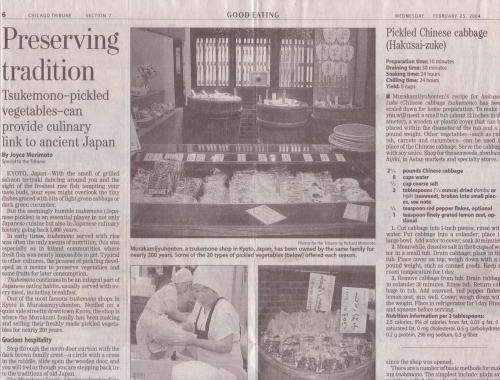
CHICAGO TRIBUNE
FEBRUARY 25,2004
GOOD EATING

PreServing tradition
Tsukemono-pickled
Vegetables-can
provide culinary
link to ancient Japan
By Joyce Morimoto
special to the Tribune
KYOTO, Japan
With the smell of grilled salmon teriyaki dancing around you and the sight of the freshest raw fish tempting your taste buds, your eyes might overlook the tiny dishes graced with bits of light green cabbage or dark green cucumber.
But the seemingly humble tsukemono (Japanese pickles) is an essential player in not only Japanese cuisine but also in Japanese culinary history, going back 1,000 years.
In early times, tsukemono served with rice was often the only means of nutrition ; this was especially so in inland communities where fresh fish was nearly impossible to get.
Typical to other cultures, the process of pickling developed as a means to preserve vegetables and some fruits for later consumption.
Tsukemono continues to be an integral part of Japanese eating habits, usually served with every meal, including breakfast.
One of the most famous tsukemono shops in Kyoto is Murakamijyuhonten.
Nestled on a quiet side streetin downtown Kyoto, the shop is where the Murakami family has been making and selling their freshly made pickled vegetables for nearly 200 years.
Step through the noren door curtain with the dark brown family crest-a circle with a cross in the middle, slide open the wooden door, and you will feel as though you are stepping back into the traditions of old Japan.
The Murakami family , who have lived in Kyoto more than 350 years, have maintained the tradition of warm and gracious hospitality.
Their staff offers a cup of tea to shoppers who need a break, or those who have to wait their turn for
assistance when the small shop is crowded, which is often.
Their loyal customers come not only from all across Kyoto and Japan but also from around the world.
"It's fresh and doesn't taste as if there were additives or preservatives [added] that some of the store-bought tsukemono has," said Susie Sakayori, a shopper at the market.
The people of Kyoto have a great, sensitivity to nature and the changing seasons and this is reflected in tsukemono. Murakamijyuhonten offers about 20 types each season based on the vegetables that are harvested at their peak and immediately processed.
The shop offers tsukemono made from nasu (eggplant), hakusai (Chinese cabbage), kyuuri (thin Japanese cucumbers) , daikon (white radish) and uri (a type of gourd). Large wooden barrels hold the most recently packaged tsukemono, and even more selections are in self-serve display cases.
The various types of tsukemono are as beautiful as they are tasty: bright, fresh green kyuuri tsukemono; nasu that is deep purple or magenta if it has been pickled with a leaf called shiso; creamy white daikon with flecks of yellow lemon peel.
The art of tsukemono-making, while practiced throughout Japan, was refined in Kyoto.
Where but in Kyoto would you find tsukemono that is an authentic bridge to the culinary traditions of ancient Japan?
Kyoto is a city of history and beauty in the midst of flashing neon signs, tall concrete buildings and masses of people.
Founded in the 790s and once the imperial capital of Japan, it remains the center of Japanese tradition and culture.
Kyoto brings to mind images of ancient wooden Buddhist temples and Shinto shrines , peaceful rock gardenes , geisha in beautiful silk kimonos , and traditional arts and crafts.
But Kyoto is also well-known for delicious food and artful cuisine, called kyo-ryori, and comes in many forms from steaming bowls of simple noodles to elegant, multicourse kaiseki dinners.
Regardless of the dining experience, tsukemono is consistently offered as part of every meal.
Murakamijyuhonten has continued to make their tsukemono using the same basic recipes and methods passed down over the generations.
They use vegetables grown in specific areas surrounding Kyoto. Masayuki Fukuoka, executive director of Murakamijyuhonten, explained through an interpreter that the temperature, humidity , type of soil and quality of the water all make Kyoto vegetables delicious and unique.
The tsukemono at Murakamijyuhonten is made entirely by hand in small quantities.
For their hakusai tsukemono , they begin with 110 pounds of Chinese cabbage , which yields about 66 pounds of tsukernono.
The pickles range from $2.50 to $5 per 7-ounce package.
A visit to the workshop connected to the store where most of the tsukemono is made is bustling with a dozen workers and full of 2-foot-tall blue plastic containers filled with vegetables at various stages of production, each with wooden lids weighted down by 44-pound stones that press out the liquid from the vegetables. Crystal-clear water for the production comes from a 213-footdeep well below the shop that has been used since the shop was opened.
There are a number of basic methods for making tsukemono.
The simplest include: plain salt pickling, called shio-zuhe, where vegetables are sliced sprinkled with salt and pressed; and vinegar pickling called su-zuke, where vegetable slices are soaked in arice vinegar mixture.
Asazuke is a method where vegetables are preserved in dry rice bran, called nuka, and salt, These pickles are delicate and must be eaten in afew days to ensure freshness and the best flavor.
Furu-zuke uses nuka that has been mixed with water and salt.
These prckles last longer and have a more intenes pickled taste.
Perhaps the most famous and most traditional is senmai-zuke, winter tsukemono made from large, white turnips called kabura, three types of kombu (dried seaweed), and salt.
For many Japanese , the end of fall is official when the kabura are harvested ; the winter season truly begins when senmai-zuke can be enjoyed once again.